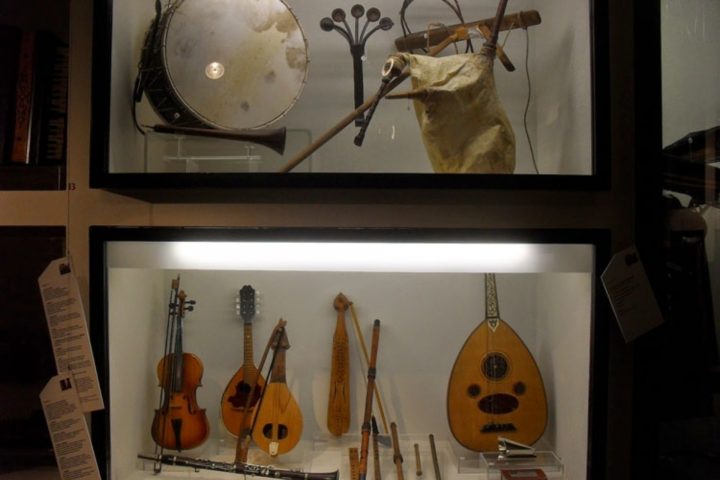The Historical and Folklife Museum of New Orestiada and Region, founded in 1974, is dedicated to the study and promotion of the local cultural inheritage.
After three years of renovation works, on 2 May 2010, the Historical and Folklife Museum of New Orestiada and Region has reopened the exhibition for the public. The museum is open daily from Tuesday to Sunday, opening hours: 10.00 – 13.00.
A new three-storey wing of 360 sq. meters area has been added to the museum and the total exhibition area of the museum has now reached 585 sq. meters. Furthermore, an extensive renovation has been carried out. Specialists and professionals from the fields of museology, architecture and ethnology have planned and supervised the renovation works. This effort was financed by the “Stavros Niarchos” foundation, organizations, corporations and foundations which generously sponsored the museum. Part of the renovation works was funded by European projects.
After three years of renovation works, on 2 May 2010, the Historical and Folklife Museum of New Orestiada and Region has reopened the exhibition for the public. The museum is open daily from Tuesday to Sunday, opening hours: 10.00 – 13.00.
A new three-storey wing of 360 sq. meters area has been added to the museum and the total exhibition area of the museum has now reached 585 sq. meters. Furthermore, an extensive renovation has been carried out. Specialists and professionals from the fields of museology, architecture and ethnology have planned and supervised the renovation works. This effort was financed by the “Stavros Niarchos” foundation, organizations, corporations and foundations which generously sponsored the museum. Part of the renovation works was funded by European projects.
Noted that the new museum is suitable for visit by disabled people.The Historical and Folklife Museum of New Orestiada and Region presents the history of New Orestiada, the city foundation, as well as snapshots of the everyday life of its inhabitants. Visitors of the museum enjoy a trip in time and the region’s history. The exhibits which are organized in thematic collections and digital media contribute in giving the visitors a glimpse of the life in Karagats and New Orestiada. Some of the most important exhibits of the museum are the holy relics of St. Cyrillus VI, patriarch of Constantinoupolis, which till recently were at the Benaki Museum in Athens. The majority of the exhibits are donations from the region’s inhabitants.
The visitor of the museum is firstly informed about the recent history of the region. References are made to the ancestral hearths of the citizens of New Orestiada in printed historical documents and photographs set on vertical surfaces at the museum. At the ground floor of the old wing, oral accounts are heard about the relocation of the refugees and and the foundation of the new city. A carriage is exhibited loaded with the refugees’ household ware. Soils from the lost homelands are also presented.
On the ground floor of the new wing, traditional carriages used as transport vehicles, are exhibited. Agricultural tools and machines are presented.Photographs are projected about the foundation of the new city and the life at the early days.
On the first floor, church vessels from Karagats and Adrianoupolis as well as holy relics of St. Cyrillus VI are exhinited. The visitor may view traditional musical instruments of the region and hear how they sound using a touch screen. Professional tools are also exhibited accompanied by photographs and informative texts and labels. Traditional professions are presented using a touch screen, in order to choose the corresponding documentary.
On the ground floor of the new wing, traditional carriages used as transport vehicles, are exhibited. Agricultural tools and machines are presented.Photographs are projected about the foundation of the new city and the life at the early days.
On the first floor, church vessels from Karagats and Adrianoupolis as well as holy relics of St. Cyrillus VI are exhinited. The visitor may view traditional musical instruments of the region and hear how they sound using a touch screen. Professional tools are also exhibited accompanied by photographs and informative texts and labels. Traditional professions are presented using a touch screen, in order to choose the corresponding documentary.
At the next room many traditional costumes from the broader Orestiada region are exhibited. A fully furnished dining-room and a fully furnished bedroom are presented. Furthermore, the visitor my use a touch screen in order to get analytically informed about the museum’s and region’s history.
On the second floor, historical documents referring on the life of the refugees as well as military historical documents and weaponry are exhibited. Personal belongings of Spyros Dasios, founder of the city of New Orestiada are also exhibited. A documentary about New Orestiada and Region is projected. The documentary presents both the history and the modern city and region, the entertainment, the activities and achievements of the inhabitants.
On the second floor, historical documents referring on the life of the refugees as well as military historical documents and weaponry are exhibited. Personal belongings of Spyros Dasios, founder of the city of New Orestiada are also exhibited. A documentary about New Orestiada and Region is projected. The documentary presents both the history and the modern city and region, the entertainment, the activities and achievements of the inhabitants.


